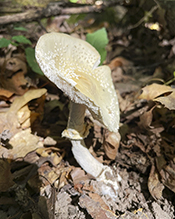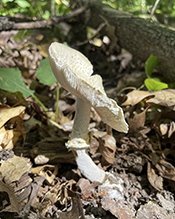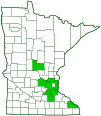Great Funnel-Veil Amanita
(Amanita velatipes)
Conservation • Description • Habitat • Ecology • Distribution • Taxonomy
Conservation Status |
|
|||||||
| IUCN Red List | not listed |
|||||||
| NatureServe | not listed |
|||||||
| Minnesota | not listed |
|||||||
Description |
||
Great Funnel-Veil Amanita is a large, robust, gilled mushroom. It occurs in the United States from Maine to northern Florida, west to eastern Minnesota and northeastern Arkansas, and in southern Canada from Nova Scotia west to Ontario. It is found in summer and fall alone, scattered, or in groups but not clustered (gregarious). It grows on the ground under or near hardwoods, especially oaks, and conifers. It has a mutually beneficial relationship (mycorrhizal) with the tiny rootlets of hardwood and coniferous trees, absorbing sugars and amino acids while helping the tree absorb water. When it first appears, the fruiting body is entirely enclosed in a universal veil. Later, the young cap is oval or egg-shaped and brownish. The upper surface is covered with numerous, whitish warts, remnants of the universal veil. The warts are closely spaced and arranged more or less in concentric circles, especially near the margins. Between the warts the cap is hairless and sticky. As it matures, the cap spreads out and the color fades. The warts bend upward at the edges and easily wash off in the rain or just fall away. Mature caps are 2″ to 7″ (5 to 18 cm) in diameter; convex, broadly convex, or nearly flat; and light brown, sometimes tinged with yellow but rarely entirely yellow. The upper surface is dry but becomes sticky when wet. The gills are white and crowded. They may be attached to the stem (adnate) or unattached (free). Between the main gills there are frequent short gills. The stalk is white, 3″ to 8″ (8 to 20 cm) long, and 3⁄16″ to ¾″ (5 to 20 mm) thick. It is more or less equally thick from the top to an expanded, bulb-like base. At the base there is a tightly adhering sack of tissue (volva), a remnant of the universal veil, that is often folded over at the upper edge. The growing stem often rips the tissue apart near the upper edge, leaving concentric rings or rows of warts near the top of the bulb. Near the top of the stalk, sometimes at or below the middle, there is a ring of tissue, a remnant of the partial veil. As the mushroom grows the base of the ring tightly adheres to the stalk while the remainder is pulled upward, becoming funnel-shaped. This feature, and the mushroom’s often large size, give the species its common name. Above the ring the stalk is silky hairy, below the ring it is finely or shaggy hairy. The flesh is white. It does not change color when sliced. It is poisonous. The spore print is white. |
||
Similar Species |
||
Habitat and Hosts |
||
Hardwoods and conifers |
||
Ecology |
||
Season |
||
Spring and summer |
||
Distribution |
||||
|
Sources |
|||
| 1/31/2023 | ||||
Occurrence |
||||
|
||||
Taxonomy |
|||
| Kingdom | Fungi (Fungi) | ||
| Subkingdom | Dikarya | ||
| Phylum | Basidiomycota (Basidiomycete Fungi) | ||
| Subphylum | Agaricomycotina (Higher Basidiomycetes) | ||
| Class | Agaricomycetes (Mushrooms, Bracket Fungi, Puffballs, and Allies) | ||
| Subclass | Agaricomycetidae | ||
| Order | Agaricales (Common Gilled Mushrooms and Allies) | ||
| Suborder | Pluteineae | ||
| Family | Amanitaceae (Amanita mushrooms and allies) | ||
| Tribe | Amaniteae | ||
| Genus | Amanita (Amanita mushrooms) | ||
| Subgenus | Amanita | ||
Section |
Amanita | ||
Subsection |
Pantherinae | ||
Synonyms |
|||
Amanita pantherina var. velatipes Venenarius velatipes |
|||
Common Names |
|||
Great Funnel-Veil Amanita Veiled-bulb Amanita |
|||
Glossary
Mycorrhizal
A symbiotic, usually beneficial relationship between a fungus and the tiny rootlets of a plant, usually a tree.
Partial veil
A protective covering over the gills or pores of a developing mushroom. At maturity it disappears, collapses into a ring around the stem, or wears away into a cobwebby covering and ring zone.
Universal veil
An egg-like structure that envelopes all or most of a developing gill mushroom. Remnants of the universal veil sometimes visible on a mature mushroom are patchy warts on the cap, a ring on the stem, and a volva at the base of the stem.
Volva
Also called cup. A cup-like covering at the base of a mushroom stem, sometimes buried. In Amanita, Volvariella, and some other mushrooms, it is the remnants of the universal veil ruptured by the mushroom pushing through. In Phallales it is the remnants of the ruptured peridium.
Visitor Photos |
|||||
Share your photo of this fungus. |
|||||
| This button not working for you? Simply email us at info@MinnesotaSeasons.com. Attach one or more photos and, if you like, a caption. |
|||||
Honey Fae (Farah) |
|||||
 |
 |
||||
MinnesotaSeasons.com Photos |
|||||
|
|||||

Visitor Videos |
|||
Share your video of this fungus. |
|||
| This button not working for you? Simply email us at info@MinnesotaSeasons.com. Attach a video, a YouTube link, or a cloud storage link. |
|||
Other Videos |
|||

Created: 1/31/2023
Last Updated:




